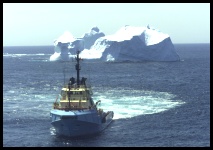
 Towing icebergs was first demonstrated near Newfoundland, Canada. Icebergs are common in the waters there - they drift down into the North Atlantic from the massive glaciers of Greenland. A vessel navigates around a berg with a floating tow line and the berg is lassoed. Tow tension is applied carefully to avoid rolling the berg or pulling the line over the top. Once secure, the ice is pulled along.
The huge masses of ice just drift along - without navigators - and they can be a serious danger to ships, or even grind into the shoreline and possibly block harbors. And can you imagine a gigantic iceberg drifting into an offshore oil drilling platform? Not only would the drilling rig be destroyed, but there could be oil spills as well. "Managing" the floating behemoths is therefore important - approaching bergs are watched carefully, and any that appear to be on a collision path are roped and moved enough to change their course.
|

|
DICTIONARY: Just "double-click" any unlinked word on this page for the definition from Merriam-Webster's Student Electronic Dictionary at Word Central. |

|
ARCTIC LIBRARY & GLOSSARY: Check this section for an index of the rest of the things you really need to know about the Arctic. |

|
ARCTIC MAPS & WEATHER REPORTS: Maps of the Northwest Passage, explorers' routes, iceberg sources, Nunavut, the Arctic by treeline, temperature... |

|
ARCTIC LINKS: Even more information! Links to sites related to the Arctic and "Iceberg: the Story of the Throps and the Squallhoots". |

|
GUIDE TO ARCTIC SUNRISE & SUNSET: How much sunlight or darkness is there in the Arctic on each day of the year? |
to is the property of their respective owners, and Athropolis is not responsible for their content.

